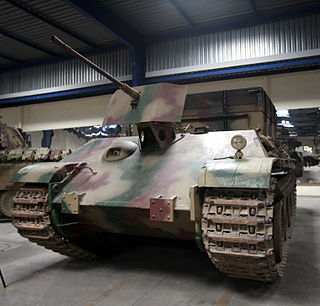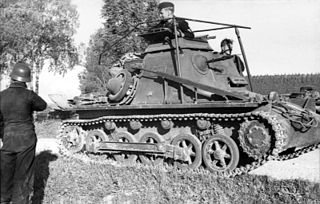
The Panzer I was a light tank produced by Nazi Germany in the 1930s. Its name is short for Panzerkampfwagen I, abbreviated as PzKpfw I. The tank's official German ordnance inventory designation was Sd.Kfz. 101.

The Panzer II is the common name used for a family of German tanks used in World War II. The official German designation was Panzerkampfwagen II.

The Panzerkampfwagen III, commonly known as the Panzer III, was a medium tank developed in the 1930s by Germany, and was used extensively in World War II. The official German ordnance designation was Sd.Kfz. 141. It was intended to fight other armoured fighting vehicles and serve alongside and support the similar Panzer IV, which was originally designed for infantry support.

The Panzerkampfwagen IV, commonly known as the Panzer IV, is a German medium tank developed in the late 1930s and used extensively during the Second World War. Its ordnance inventory designation was Sd.Kfz. 161.

The Panzerkampfwagen 38(t), originally known as the ČKD LT vz. 38, was a tank designed during the 1930s, which saw extensive service during World War II. Developed in Czechoslovakia by ČKD, the type was adopted by Nazi Germany following the annexation of Czechoslovakia. With the German Army and other Axis forces, the type saw service in the invasions of Poland, France and the USSR. Production ended in 1942, when its main armament was deemed inadequate. In all, over 1,400 Pz. 38(t)s were manufactured. The chassis of the Pz. 38(t) continued to be produced for the Marder III (1942–1944) with some of its components used in the later Jagdpanzer 38 (1944–1945) tank destroyer and its derivative vehicles.

The Sd.Kfz. 251 half-track was a World War II German armored personnel carrier designed by the Hanomag company, based on its earlier, unarmored Sd.Kfz. 11 vehicle. The Sd.Kfz. 251 was designed to transport the Panzergrenadier into battle. Sd.Kfz. 251s were the most widely produced German half-tracks of the war, with at least 15,252 vehicles and variants produced by seven manufacturers. The utility of this vehicle led the German Army to develop the similar looking but shorter and lighter Sd.Kfz. 250 as a supplement.

The 15 cm sIG 33 (Sf) auf Panzerkampfwagen 38(t), also known as Grille was a series of self-propelled artillery vehicles used by Nazi Germany during World War II. The Grille series was based on the Czech Panzer 38(t) tank chassis and used a 15 cm sIG 33 infantry gun.

The 2 cm KwK 30 L/55(2 cm Kampfwagenkanone 30 L/55) was a German 2 cm cannon used as the main armament of the German Sd.Kfz.121 Panzerkampfwagen II light tank and various reconnaissance vehicles. It was used during the Spanish Civil War and the Second World War. It was produced by Mauser and Rheinmetall-Borsig from 1935.

The 5 cm KwK 38 L/42(5 cm Kampfwagenkanone 38 L/42) was a German 50 mm calibre cannon used as the main armament of variants of the German Sd.Kfz. 141 Panzerkampfwagen III medium tank during the Second World War..

The Bergepanzerwagen V, often referred to as the "Bergepanther", was an armoured recovery vehicle used by the German Army in WWII. It was a variant of the Panzerkampfwagen V Panther.
The Panzerkampfwagen I was a light tank produced in Germany in the 1930s. The Panzer I was built in several variants and was the basis for a number of variants listed below.

The kleiner Panzerbefehlswagen, known also by its ordnance inventory designation Sd.Kfz. 265, was the German Army's first purpose-designed armoured command vehicle; a type of armoured fighting vehicle designed to provide a tank unit commander with mobility and communications on the battlefield. A development of the Army's first mass-produced tank, the Panzer I Ausf. A, the Sd.Kfz. 265 saw considerable action during the early years of the war, serving in Panzer units through 1942 and with other formations until late in the war.

This article deals with the tanks serving in the German Army throughout history, such as the World War I tanks of the Imperial German Army, the interwar and World War II tanks of the Nazi German Wehrmacht, the Cold War tanks of the West German and East German Armies, all the way to the present day tanks of the Bundeswehr.

The Panzerkampfwagen I Ausf. F, also known as VK 18.01, was a German light tank from World War II. Despite the fact that it was designated as a modification of the light tank Panzer I, the VK.18.01 was a completely new vehicle, had almost nothing to do with it. The Pz.Kpfw.I Ausf.F was created in 1942 as a light tank designed to storm fortified lines. In that same year, 30 units were produced. From 1943 it was used for anti-guerrilla operations on the Eastern Front and in Yugoslavia. Thirty Ausf F tanks were built between April and December 1942, eight of which were sent to the Eastern Front for evaluation.

The Panzerkampfwagen II Ausf. L "Luchs" is a German light tank from the Second World War, developed between 1940 and 1942 by Daimler-Benz and MAN. The Luchs was the only Panzer II design with the Schachtellaufwerk overlapping/interleaved road wheels and "slack track" configuration to enter series production, with 100 being built from September 1943 to January 1944 in addition to the conversion of the four Ausf. M tanks. Originally given the experimental designation VK 13.03, it was adopted under the alternate name Panzerspähwagen II and given the popular name Luchs. The Luchs was larger than the Panzer II Ausf. G in most dimensions. With a six speed transmission, it could reach a speed of 60 km/h (37 mph) with a range of 260 km (160 mi). The FuG 12 and FuG Spr radios were installed, while 330 rounds of 20 mm and 2,250 rounds of 7.92 mm ammunition were carried.














